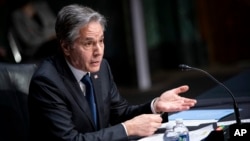The United States plans to more fully outline its policy toward China ahead of a series of high-profile meetings with Asian leaders, and the first in-person meeting between U.S. and Chinese defense chiefs in June.
Secretary of State Anthony Blinken was expected to make a major policy speech this week outlining the administration’s approach to relations with China. The speech was postponed after the secretary tested positive for COVID-19 on Wednesday.
The U.S.’s China policy likely will be a part of the U.S.-ASEAN summit next week in Washington, as well as the Quad summit later this month in Tokyo, where President Joe Biden will meet with counterparts from Australia, India and Japan.
President Biden has emphasized that Washington and Beijing need to establish “guardrails” to avoid unintended conflicts while managing great power competition with China.
Those are expected to be a feature of talks between defense chiefs from the United States and China during the so-called Shangri-La Dialogue in Singapore, a high-level Asia security summit.
Keeping military communications open
This year’s annual Shangri-La Dialogue will be held from June 10–12. It was last held in 2019 and canceled in consecutive years due to the COVID-19 pandemic.
U.S. Secretary of Defense Lloyd Austin told the Senate Appropriations Committee on Tuesday that he hoped the meeting with China’s Minister of National Defense Wei Fenghe can “promote security and stability in the region.”
“We both recognize the importance of a dialogue and maintaining open channels,” said Austin. “I look forward to again, engaging him in the future — in the not-too-distant future.”
This would be their first in-person meeting since President Biden took office. Austin and Wei spoke over the phone on April 20. The two sides provided different accounts of the conversation afterward.
Some experts said while it is significant that both the U.S. and China are "demonstrating to the region that there are lines of communication,” the security gathering itself cannot solve longstanding problems between the two countries.
“The two sides would have the appearance of being cordial and professional but the meeting itself would be likely reading scripts,” said Drew Thompson, a senior research fellow at the National University of Singapore's Lee Kuan Yew School of Public Policy.
Improving US competitiveness with China
State Department Counselor Derek Chollet told VOA in a recent interview that elements of the U.S.-China relationship are “conflictual,” “competitive,” with areas on which the countries fundamentally disagree. He said the space for cooperation between the U.S. and China is “dwindling” after Russia’s war on Ukraine.
This week, the U.S. Senate passed the United States Innovation and Competition Act of 2021. If signed into law, the bill would pay for billions to support semiconductor manufacturing and enhance the U.S. capability to compete with Chinese technology.
Secretary of State Blinken’s China speech is expected to underscore the government’s plan to invest more in U.S. strategic interests, such as high-tech products like semiconductors, as part of a broader push to improve U.S. competitiveness with China.
“We have strengthened our capacity to shape the ongoing technological revolution so that it actually protects our interests. It boosts our competitiveness, it upholds our values,” Blinken told the Senate Foreign Relations Committee last week.
The U.S. government considers China a strategic competitor, with Beijing seeking to grow its military and economic influence around the world. There have been clashes over tariffs and technology secrets, as well as regional flashpoints that have the potential to spiral into armed conflict, including in the Taiwan Strait and the South China and East China seas.
“When it comes to Taiwan,” Blinken told U.S. lawmakers last Tuesday, “we are determined to make sure that it has all necessary means to defend itself against any potential aggression, including unilateral action by China to disrupt the status quo that's been in place now for many decades.”
China considers self-ruled Taiwan a breakaway province and has not ruled out the use of force to reunify the two sides.







